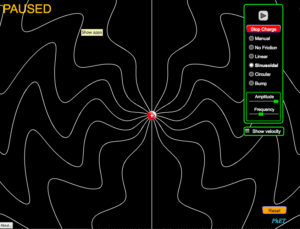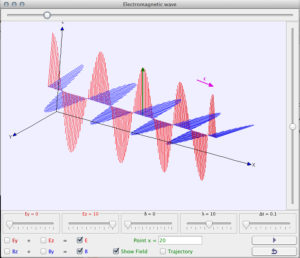Color Physics @Hampshire, Day 7
On Day 7, we finally got to understand what electromagnetic waves are.
- Students used a wonderful HTML-based simulation of a radiating charge to explore how motion of an electrically charged particle affects its electric field lines. They wrote their observations, the key ones which we discussed as a class.

A screenshot of the PhET simulation of an oscillating electric charge and its electric field. - After briefly talking about the creation of magnetic field by a changing electric field and vice versa (mostly in a hand-wavy way), we moved on to the more familiar representation of the electromagnetic wave far away from wiggling charged particle. For this we used a very nice Java simulation developed by Juan M. Aguirregabiria, the screenshot of which is shown below. The shift inspired a good discussion of the pros and cons of the two visual representations of the electric field (arrows and field lines) and the relation between the depictions of electromagnetic radiation in the two simulations.
 A screenshot of a simulation of a plane electromagnetic wave.
A screenshot of a simulation of a plane electromagnetic wave.
- After discussing different types of electromagnetic radiation (UV, visible light, WiFi, microwave) and its effects and uses, we began discussing what it takes to make a wave in general.